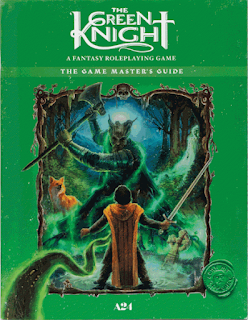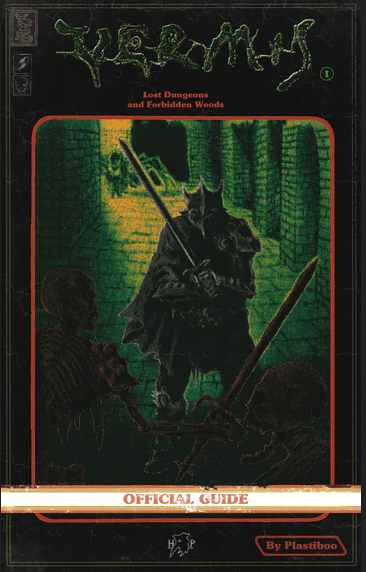Vermis 2: Mist & Mirrors Review (w/ bonus Scooby Doo Hallway portals!)
 The dim light of a single bulb illuminates the messy stacks of dusty boxes in your attic. Treasures await. You hone in on what you seek. The lid of the foot locker creaks open on its damaged hinges. A rag of stray webbing clings to the interior, and the spider lays dead atop the messy stack of comics and roleplaying modules. Peeking out is the video game guide you seek, Vermis II: Mist & Mirrors. The rediscovery of Vermis ignited your curiosity, and you thought of the sequel you bought but never remember playing. You can't find the game disc in the foot locker. Good enough for now, you think, I can dig through the guide and pick up a copy later. You sit down on a cardboard box, flipping the cover open.
The dim light of a single bulb illuminates the messy stacks of dusty boxes in your attic. Treasures await. You hone in on what you seek. The lid of the foot locker creaks open on its damaged hinges. A rag of stray webbing clings to the interior, and the spider lays dead atop the messy stack of comics and roleplaying modules. Peeking out is the video game guide you seek, Vermis II: Mist & Mirrors. The rediscovery of Vermis ignited your curiosity, and you thought of the sequel you bought but never remember playing. You can't find the game disc in the foot locker. Good enough for now, you think, I can dig through the guide and pick up a copy later. You sit down on a cardboard box, flipping the cover open. The knells of the bell echo along the endless corridors. The mist engulfs everything. Those glassy eyes that chase you wherever you go are none but your own. You eagerly devour the age-faded pages, losing track of time in the quiet attic, finding yourself in the world of the Glass Purgatory.
Vermis II: Mist & Mirrors, follows the enigmatic Vermis: Lost Dungeons and Forbidden Worlds, which took the scene by storm with its meta-conceit of a text from an alternate past, a supplement to a nonexistent game, introducing mysteries that cannot be solved. Mist & Mirrors is noticeably different in its format, shorter and wider. It looks unwieldy on the shelf next to the first book. Inside, however, the format suits the art, which is much more open. Vermis I had a cramped, grungy layout, and this book has more space and more text, with fewer insets of things of life bars, alignment and condition icons and the like.
Mist & Mirrors is a narrative, focusing on a character called the Wayfarer. He is an outcast who worships Ghylak, the cursed one, the two-headed snake god of death and darkness. The Wayfarer seeks a remedy for the curse that afflicts his god. It is a deep dive into the quest of a bone-picker afflicted by a disease/curse, tightly focused and linear, and told in the third person present tense, rather like watching an animated cutscene with scrolling text. It leaves the reader out, which is contrary to the player's first person perspective, but opens up a "novel" possibility- as a companion novelization to the game, similar to Stonekeep (and perhaps more that I'm not aware of). Still, it is labeled "Game Guide", and in terms of that format it fails, at least in my opinion.The focus is on desert temples and the misty Glass Purgatory. The Bone Hunter of Ghylak is introduced with his starting equipment and ethos, as well as the curse that pushes him onward; the shadow figures that pursue him. The narrative is occasionally broken by lore on characters which do not seem to appear within the current location- loading screens, perhaps? The information is interesting, particularly the Goblin Queen, which ties satisfyingly back to the first volume.
I expected the focus to shift from the narrative after a bit, but it doesn't; it is thoroughly about the Wayfarer's journey, and chronicles it extensively. The challenges and encounters are more or less resolved before your eyes, making you wonder what would be there if you were exploring after the Wayfarer seems to have completed the true journey. It seems somewhat like playing in Middle Earth after the war of the ring is resolved- are you important? Will your adventures be meaningful? There is something within the book which recontextualizes this a bit, an easter egg or meta-narrative implying more to the events, but it is somewhat obscure and doesn't quite address the issue, for me at least.The narrative is structured as a series of mirrors and illusions, each a dungeon, puzzle or boss fight. It's a bit one-note, but visually gorgeous. Wayfarer traverses the fog/mirror/glass door/reflective liquid ---> Wayfarer fights boss ---> Wayfarer collapses from wounds ---> repeat. It's rather difficult to follow the thread. I've had to put this book down many times, then restart near the beginning to get my bearings again. It took 5-6 sittings to digest, and I considered shelving it multiple times throughout- as opposed to the first volume, which I rapidly converted an excerpt of (The Pauper's Catacombs) and ran it as a one-shot. To be fair, immediately on finishing it, Mist & Mirrors raised questions and had me flipping backwards to find the hidden details, and I now feel much more positive about it. I'm not sure, however, that even knowing this could motivate someone to finish it in 1-2 sittings because it is just so hard to parse. There is something to be said, however, that a book of misty, mirrored illusions forces you to repeat, to question, and to process what you remember.
The best parts of Mist & Mirrors are in the introduction, where the worldbuilding is focused, mysterious but evocative, and the end, where there is finally some variety and it introduces some enigmas to dig into. In between is a confusing journey that tested my patience more than it engrossed me in its world. Still, I have to applaud Plastiboo and Hollow Press for creating something unique within the RPG/artbook/meta genre, and am glad to have it for inspiration.
555/666
Bonus Gameable Content: Scooby Doo Door Hallway
Put a bunch of doors in a hallway, preferably close by and facing each other. Assign a number to each door, then roll a die with the same number of faces to determine where each door exits. The doors could have a room behind them, or a hallway, or just be a direct portal to the exit (in one, out the other). Going in reverse may take you out a different door than you'd expect. Some doors may have many "feeder" doors that go outward from it, and some may have none. That's just the way it works, the Scooby Gang never knew where they were going to pop out, they just had to get away from the Phantom, man! It could conceivably serve as a puzzle, as well- perhaps some doors lead into closed-off areas, but are one-way and it requires finding a sequence to get out. Who knows?
See the diagram below for an example.











Comments
Post a Comment